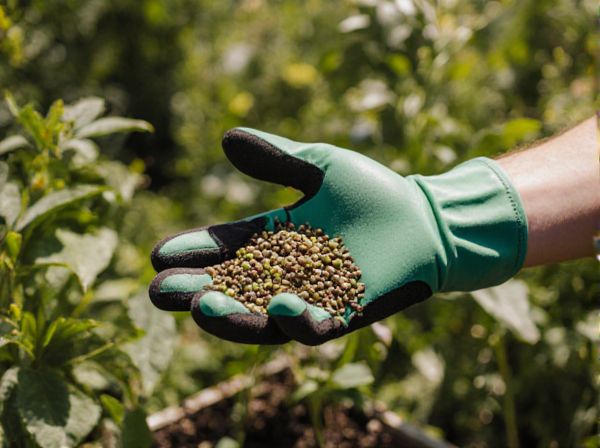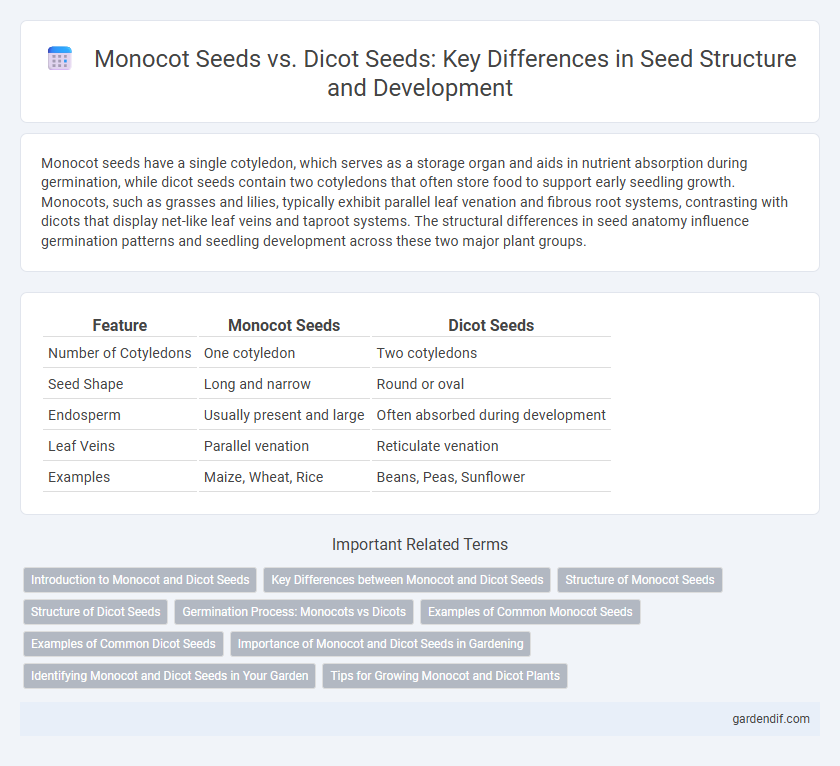
Monocot seeds vs Dicot seeds Illustration
Monocot seeds have a single cotyledon, which serves as a storage organ and aids in nutrient absorption during germination, while dicot seeds contain two cotyledons that often store food to support early seedling growth. Monocots, such as grasses and lilies, typically exhibit parallel leaf venation and fibrous root systems, contrasting with dicots that display net-like leaf veins and taproot systems. The structural differences in seed anatomy influence germination patterns and seedling development across these two major plant groups.
Table of Comparison
| Feature | Monocot Seeds | Dicot Seeds |
|---|---|---|
| Number of Cotyledons | One cotyledon | Two cotyledons |
| Seed Shape | Long and narrow | Round or oval |
| Endosperm | Usually present and large | Often absorbed during development |
| Leaf Veins | Parallel venation | Reticulate venation |
| Examples | Maize, Wheat, Rice | Beans, Peas, Sunflower |
Introduction to Monocot and Dicot Seeds
Monocot seeds contain a single cotyledon that stores nutrients for the developing embryo, while dicot seeds possess two cotyledons that often serve as the primary storage organs. Monocots typically feature parallel venation and fibrous root systems, whereas dicots exhibit net-like leaf venation and taproot systems. Seed structure differences impact germination and seedling development, reflecting evolutionary adaptations in angiosperms.
Key Differences between Monocot and Dicot Seeds
Monocot seeds contain a single cotyledon while dicot seeds have two cotyledons, impacting nutrient absorption and seedling development. Monocot seeds typically possess endosperm that stores food, whereas dicot seeds often transfer food to the cotyledons before germination. Seed coat thickness and vein patterns in the seed leaves also distinguish monocot and dicot seeds, with monocots showing parallel venation and dicots displaying net-like venation.
Structure of Monocot Seeds
Monocot seeds possess a single cotyledon that functions in nutrient absorption rather than storage, which distinguishes them from dicot seeds that have two cotyledons storing food. The embryo of monocot seeds is enclosed within a protective sheath called the coleoptile, aiding in the emergence of the shoot during germination. Endosperm constitutes a significant portion of monocot seeds, providing essential nourishment to the developing embryo.
Structure of Dicot Seeds
Dicot seeds typically feature two cotyledons that store nutrients essential for seedling growth. The seed coat provides protection, while the embryo contains a well-defined radicle and plumule for root and shoot development. This structural design supports efficient germination and early plant establishment.
Germination Process: Monocots vs Dicots
Monocot seeds, such as corn and wheat, undergo germination where the single cotyledon absorbs nutrients and the coleoptile protects the emerging shoot. Dicot seeds like beans exhibit germination through the absorption of water, swelling, and the emergence of two cotyledons that provide stored nutrients for initial growth. The root (radicle) emerges first in both seed types, but monocots rely on a protective sheath for the shoot, whereas dicots have a more pronounced seed leaf structure aiding in early photosynthesis.
Examples of Common Monocot Seeds
Common monocot seeds include maize, wheat, rice, barley, and oats, which belong to the grass family Poaceae. These seeds typically have a single cotyledon that aids in nutrient absorption during germination. Monocot seeds are characterized by parallel vein leaves and fibrous root systems, distinguishing them from dicot seeds.
Examples of Common Dicot Seeds
Common dicot seeds include beans, peas, lentils, and peanuts, which typically have two cotyledons that store food for the developing embryo. Unlike monocot seeds like maize or wheat, dicot seeds exhibit net-like leaf venation and the presence of vascular bundles in a ring within the stem. These structural differences influence seed germination and plant growth patterns.
Importance of Monocot and Dicot Seeds in Gardening
Monocot seeds, such as corn and wheat, are essential in gardening due to their rapid germination and adaptability to various soil types, promoting efficient crop production. Dicot seeds, including beans and tomatoes, contribute significant genetic diversity and nutrient-rich yields, enhancing garden sustainability and biodiversity. Understanding the distinct growth patterns and nutrient requirements of monocot and dicot seeds enables gardeners to optimize planting strategies and improve overall garden productivity.
Identifying Monocot and Dicot Seeds in Your Garden
Monocot seeds typically have a single cotyledon, with examples like corn and wheat featuring elongated shapes and parallel leaf veins, while dicot seeds possess two cotyledons and often display a broader, rounder form such as beans and peas. Identifying monocot seeds involves spotting grass-like, narrow morphology and fibrous root systems in seedlings, whereas dicot seeds commonly show net-like leaf venation and taproot emergence. Gardeners can distinguish these seed types by examining seed shape, leaf vein patterns, and seedling root systems to ensure proper plant care and cultivation.
Tips for Growing Monocot and Dicot Plants
Monocot seeds, like corn and wheat, have a single cotyledon that influences their germination process, requiring shallow planting and consistent moisture to encourage rapid sprouting. Dicot seeds, such as beans and sunflowers, contain two cotyledons, which support early nutrient supply, necessitating deeper planting and well-drained soil to promote healthy seedling development. Understanding these key differences and tailoring watering, sunlight, and soil conditions can significantly enhance growth success for both monocot and dicot plants.
Monocot seeds vs Dicot seeds Infographic

 gardendif.com
gardendif.com